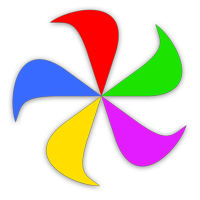If you're an experienced Moom 3 user, this chapter will try to introduce you to all the new features without going into great detail on any of them—if you want that, it's available by clicking on a topic of interest in the navigation bar at left.
Major New Features
While there are tons of new features in Moom 4, as you'll see below, these are some of the more noteworthy ones. (Click each thumbnail to see the bigger picture.)

|
Moom's pop-up menu—now called the palette) is customizable, with 66 separate spots for custom actions. And you can hide the five default actions, leaving 61 free to use. (The palette will auto-size to fit your chosen actions.) |
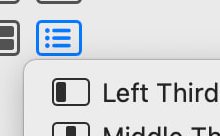
|
Folders can be added to the palette, making the limit of 61 not a limit at all—you can put hundreds of custom actions on the pop-up palette. |
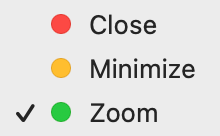
|
You can put Moom's palette onto any of the three window control buttons. |

|
The palette can be resized. |
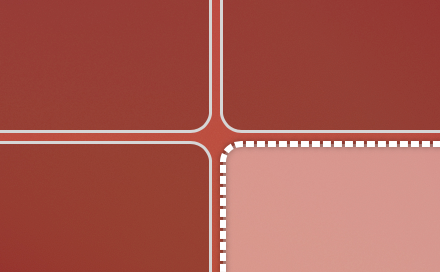
|
Drop zones let you drag a window and either activate a saved layout via a keyboard shortcut, or drag to a defined snap zone, and then drop on a window location from the saved layout. You can also drag and add a definited modifier key to instantly access drop zones. |

|
Save a window layout that applies to any windows. The one pictured will tile the six frontmost windows (across all apps) into the numbered positions. |
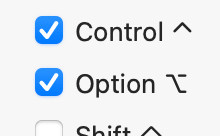
|
New Hover mode allows you to move or resize windows simply by dragging your mouse while holding down a set of modifier keys of your choice. |
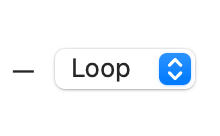
|
Chained commands can now be run as one (as before), or as separate steps, where each use of the chain's shortcut executes the next step in the chain. |
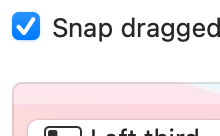
|
Snap zones are customizable—use any custom action in any snap zone…and that includes folders and layouts, which opens up an entirely new feature. |
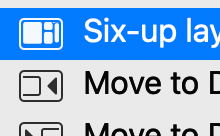
|
Create a keyboard shortcut to put Moom's custom actions into a pop-up menu. |
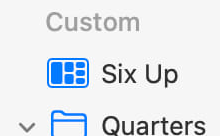
|
Totally revised Settings interface, allowing much better organization and control over Moom. |

|
Create folders to hold collections of custom actions. Not enough? Create folders within folders within folders… |
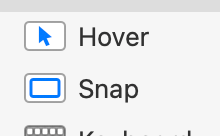
|
All four Moom modes — Palette, Hover, Snap, and Keyboard — have a dedicated section in Moom's settings. |
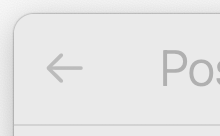
|
Add keyboard shortcuts to folders to have them appear in an pop-up menu, to easily select any custom action within the folder. |
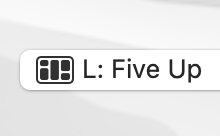
|
Folders in middle-edge snap zones will pop-up a menu, letting you select any action from within that folder by dragging the window along the screen edge. |
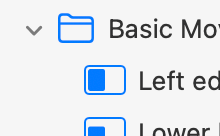
|
Every single Moom action can be renamed. |
User Interface
More new and/or revised features, beyond what's listed above:
- Moom has a colorful new application icon, as seen at the top of this chapter.
- Moom's settings can now be found in the Gear menu at the top right of the Settings window.
- Folders can be collapsed in the sidebar, making it super simple to really clean up your collection of custom actions.
- In Moom's menu bar menu, Save Window Layout Snapshot is now just Save Layout. Any other references to Snapshot have been changed to Layout, better reflecting what the feature does.
- The Settings window can optionally switch Moom to application mode while it's open, to make it easier to go back and forth between Moom and other apps while setting things up. (This is enabled by default.)
- Within the Settings window, the contextual menu contains a number of useful features, including rename, duplicate, and delete. You can also add new custom actions from the contextual menu.
- Hold ⌥ and drag-and-drop (or copy and paste) to duplicate any selection of actions. You can also use the Duplicate entry in the contextual menu.
Custom Actions
More new/and or revised features, beyond what was listed in the first section.
- There are three new custom actions: Chain (for sequential or all-as-one grouped actions), Folder (for organizing), and Use Grid (activates the overlay grid).
- Arrange Windows has been renamed to Layout, and promoted to the top of the list.
- When applied, layouts now identify windows more reliably if window titles vary slightly. In addition, all open tabs (in browsers and other tab-supporting apps) will be checked for matching window titles.
- Move & Zoom has been renamed to Move & Resize, to better reflect what it does.
- Move & Resize actions can now have custom grid size settings for each action.
- Layouts can now adapt to display configuration changes.
- Visibly detect overlapping windows in saved layouts, and include or exclude them with the click of a button.
- Resize and Move & Resize gain a "Use Active Window Size" button to set the dimensions to match the frontmost window's dimensions.
- Chains that run a sequence of actions can be set to act globally (each use picks the next action in the chain), or on a per-window basis, where each window remembers where you were in its sequence.
- If you want to restore a custom action you just deleted, the contextual menu's Recently Deleted entry makes that every easy to do.
- Window sizes and locations stored in a Layout can be extracted to new Move & Resize actions, either on a per window basis or for all windows in the saved layout.
- Existing Move & Resize actions can be duplicated as a layout—either individually, or select a number of actions and compile them into a layout.
Other New Stuff
More new/and or revised features, beyond what was listed in the first section:
- Customize the palette by dragging and dropping actions onto it, then drag to rearrange. Did we mention you can do this 61 separate times? I think we did. But still. 61!
- If you have the palette on the green button, you can disable that button's "click to enter full screen mode" functionality.
- Similarly, if you have the palette on the yellow (minimize) or red (close) buttons, you can disable those functions.
- New AppleScript command run to run any named custom action.
- Share custom actions with other local Macs via drag-and-drop or copy and paste, and use export/import to share with non-local Macs.
- Choose from three different grid/snap outline designs, and optionally animate any of the three.

